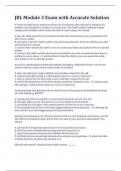Essay
AQA A level psychology essay for phobias
- Vak
- Instelling
This 16 mark essay outlines and evaluates two behavioural treatments for phobias with reference to a conversation (ao2). This is for the psychopathology topic in AQA A level psychology.
[Meer zien]












